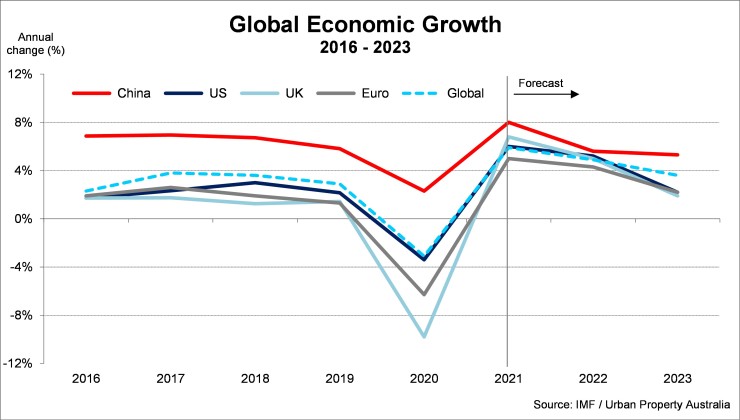Q3 2021 – Global Economic Overview
October 26th 2021 | , Urban Property Australia
- The global economy is projected to grow 5.9% in 2021 and 4.9% in 2022 with new outbreaks of the COVID-19 virus hampering the recovery in many economies;
- The recovery of Australia’s economy had been stronger than anticipated prior to the recent outbreak and the economy is expected to bounce back with restrictions now eased;
- Victoria is forecast to outperform all other Australian states with the economy expected to return to its pre-COVID-19 size by late 2021.
Economic Summary
While the Delta strain has required a more measured reopening of the economy in affected areas than in the past, the Australian economy entered this challenging period in a strong position and fiscal policy is directly supporting households and businesses in the affected areas. Australia’s economy is forecast to grow by 4.0% over 2021 and gain further momentum in coming years.
Q3 2021 – Global Economic Overview
The global economy continues to recover from the largest and sharpest decline in decades. In a number of large economies, the very substantial fiscal and monetary policy response, together with vaccinations and the associated relaxation of containment measures, enabled a rapid recovery with less economic scarring than previously feared.

The outlook over the next few years is for the global recovery to continue, underpinned by significant and ongoing policy support and vaccination programs. However, global economic conditions are likely to remain uneven for some time. New outbreaks of the COVID-19 virus, including of more transmissible variants, are currently hampering the recovery in many economies, especially where vaccination rates remain low.
According to the IMF, the global economy is projected to grow 5.9% this year and 4.9% in 2022 with economic prospects of Australia’s major trading partners solid with growth of 7% expected in 2021 and 5% in 2022.
Economic growth for advanced economies is expected to regain its pre-pandemic trend levels by 2022 whereas emerging and developing economies (excluding China) are expected to remain below pre-pandemic levels through to 2024. These economic divergences are a consequence of large disparities in vaccine access and in policy support.
United States
The IMF downgraded its economic growth 2021 projections of the United States, having been more adversely impacted by the COVID-19 Delta variant than previously anticipated. The IMF now forecasts the US economy to increase by 6.0% this year (down from previous projections of 6.4%). Bottlenecks in global supply chains made it difficult for businesses to keep up with elevated demand for many goods with consumer confidence having also been adversely impacted by the virus variants more recently. Looking ahead the US economy is projected to increase by 5.2% in 2022 as more activities normalise as the pandemic recedes.
China
China is projected to grow by 8.0 % in 2021 with economic growth forecast to slow to 5.6% in 2022, but the recovery remains unbalanced because private consumption continues to lag amid repeated outbreaks. Given China’s more advanced recovery, it is one of the first countries to normalise its macroeconomic policies. Yet, the speed and magnitude of China’s fiscal contraction in the first half of this year was much faster and bigger than anticipated, contributing to the growth slowdown. A rapid weakening of domestic demand, as seen in both household spending and corporate financing, accompanied by rising inflationary pressures, may induce policy easing.
Europe
An increasingly resilient recovery is taking hold in Europe, supported by gradual increases in vaccination rates and mobility. A large share of Europeans has been fully vaccinated: 63% on average in the EU, with a peak of 84% in Portugal. Accordingly, Europe seems to be less affected by the Delta variant compared to other regions, limiting its economic disruption. Economic growth of 5.0% is projected for 2021 across the Euro zone followed by growth of 4.3% in 2022. Like other regions of the world, shortages and supply chains disruptions continue to negatively affect activity in the manufacturing sector, especially in Germany.
United Kingdom
Latest economic indicators that recovery is gaining momentum with the IMF revising its economic projections upward for the United Kingdom. The IMF now forecasts that the UK’s economy will grow by 6.8% in 2021 (compared to 5.3% in previous projections). While headline growth and business optimism are strong – the recovery is not yet broad-based, being principally driven by the re-opening of a few sectors. Construction and re-opened sectors grew strongly in the first half of the year and the prospects for domestic tourism look good. Output is expected to return to its pre-Covid level in the first quarter of 2022.
India
India is projected to grow by 9.5% this year, one of the world’s fastest growing economies, after a sharp decline in 2020 with India’s economic recovery gaining traction according to various economic indicators. The pandemic surge earlier this year had a larger-than-expected adverse impact on growth, but the subsequent rebound in activity has gained strength, supported by favourable external conditions and policy accommodation. Exports, which account for nearly a fifth of the economy, have been growing for the past eight months signalling strong global demand will also support India’s economic recovery.
Copyright © 2021 by Urban Property Australia All rights reserved. No part of this publication may be reproduced in any form, by microfilm, xerography, electronically or otherwise, or incorporated into any information retrieval system, without the written permission of the copyright owner.



